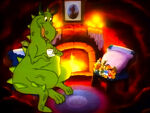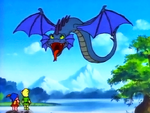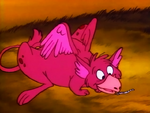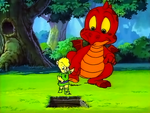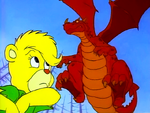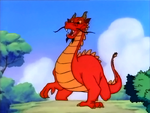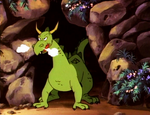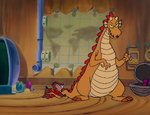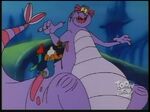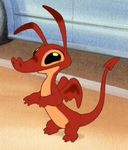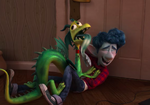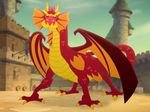Dragons are legendary creatures, typically with serpentine or reptilian traits, that are featured in the myths of many cultures.
Background
There are two distinct cultural traditions of dragons: the European dragon, derived from European folk traditions and ultimately related to Greek and Middle Eastern mythologies, and the Chinese dragon, with counterparts in Japan, Korea, and other East Asian countries. There is also the American/Canadian dragon, a dragon depicted as having characteristics from other dragons, as well as lacking arms.
Dragons are usually depicted in modern times with a body resembling a huge lizard or snake with at least two pairs of lizard-like legs, and are often able to emit fire from their mouths. The European dragon has bat-like wings growing from its back. A dragon-like creature with no front legs is known as a wyvern. Following the discovery of how the Pterosaur walked on the ground, some dragons have been portrayed without front legs and using the wings as front legs (Pterosaur fashion) when on the ground.
Although dragons occur in many legends around the world, different cultures have varying stories about monsters that have been grouped together under the dragon label. Some dragons are said to breathe fire or be poisonous. Some live in water as well. They are commonly portrayed as serpentine or reptilian, hatching from eggs and possessing typically scaly or feathered bodies. They are sometimes portrayed as having especially large eyes for watching treasure very vigilantly, a feature that is the origin of the word "dragon" (Greek drakeîn meaning "to see clearly"). Some myths portray them with a row of dorsal spines. European dragons are more often winged, while Chinese dragons resemble large snakes or serpents with legs and whiskers. Some other types of dragons also exist in legends around the world; the knucker is a small-winged, four-legged water dragon seen in western mythology, while the wyrm (sometimes spelled "wurm") is a great, legless dragon resembling nothing less than a large, horned snake with great crushing coils. Several variants exist of this type of dragon, including the legendary python of Greek legend (for which true python snakes are named) and the English dragon known as the Lambton wyrm. Another dragon from Norse, Swedish, and Danish mythology is the Lindworm (sometimes spelled as "Lindwyrm", "Lindorm", or Lindom"), which is a serpentine creature with two front legs and no wings. Amphipteres are another dragon variant that are essentially winged serpents with no legs.
In the Disney Universe, dragons are usually anthropomorphic creatures themselves or people magically turned into dragons. However, some, like the dragons in Adventures of the Gummi Bears and Tangled: The Series, are wild animals as well, such as the brine dragon, cliff dragon, and malevolent Chinese dragon, as well as the dragon named Little Big Guy that appeared in these respective series. The dragon in Tangled: The Series also adds the ability of dragons to take on attributes from people they have been in contact with, as well as giving people or other beings the dragon's abilities in return.
Disney's Dragons
Trivia
- Though not technically in its design, the Hydra from Hercules was described as a dragon or "dragon-like" in several Disney books, including Disney's Hercules: Classic Storybook, Disney's Hercules: I Made Herc a Hero by Phil, Handsome Heroes and Vile Villains: Men in Disney's Feature Animation, and The Art of Disney's Dragons.
Gallery
The Most Peaceful Dragon in the Whole World
Brine Dragon
Bubbles (Baby Cliff Dragon)
The Dreaded One
Territorial Dragon
Elliott, Mushu, Maleficent, Madam Mim, and The Reluctant Dragon (members of a group mentioned as the "101 Dragons")
The Dragon
The Curse Dragon


